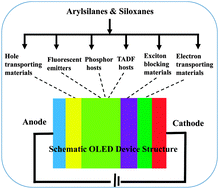Arylsilanes and siloxanes as optoelectronic materials for organic light-emitting diodes (OLEDs)
Abstract
Organic light emitting diodes (OLEDs) are currently receiving much attention for applications in new generation full-colour flat-panel and flexible displays and as sources for low energy solid-state lighting. Arylsilanes and siloxanes have been extensively studied as components of OLEDs, mainly focusing on optimizing the physical and electronic properties of the light-emitting layer and other functional layers within the OLED architecture. Arylsilanes and siloxanes display the advantages of good solubility in common organic solvents and excellent resistance to thermal, chemical and irradiation degradations. In this review, we summarize the recent advances in the utilization of arylsilanes and siloxanes as fluorophore emitters, hosts for phosphor emitters, hole and exciton blocking materials, and as electron and hole transporting materials. Finally, perspectives and challenges related to arylsilanes and siloxanes for OLED applications are proposed based on the reported progress and our own opinions.

- This article is part of the themed collection: Highlighting materials research in the UK for optical, magnetic and electronic devices

 Please wait while we load your content...
Please wait while we load your content...